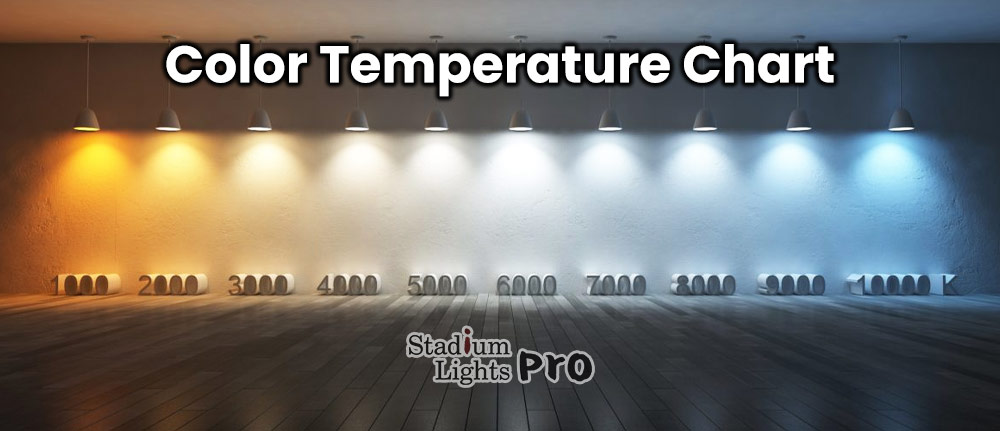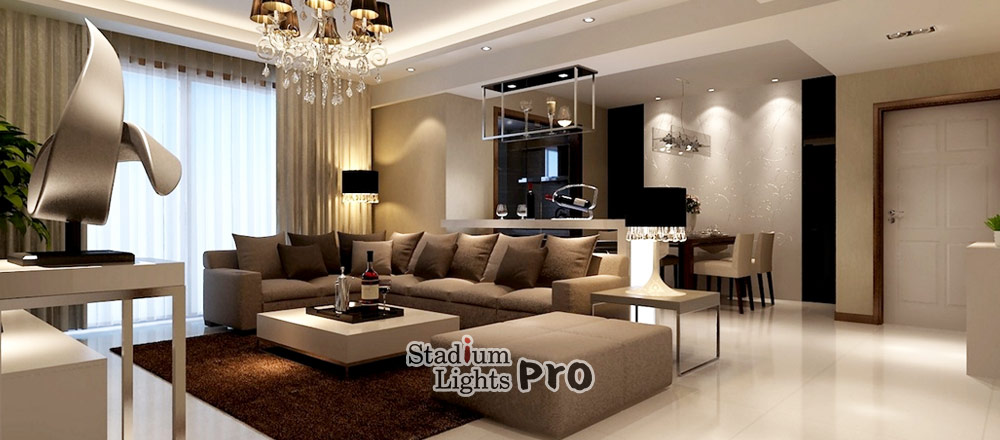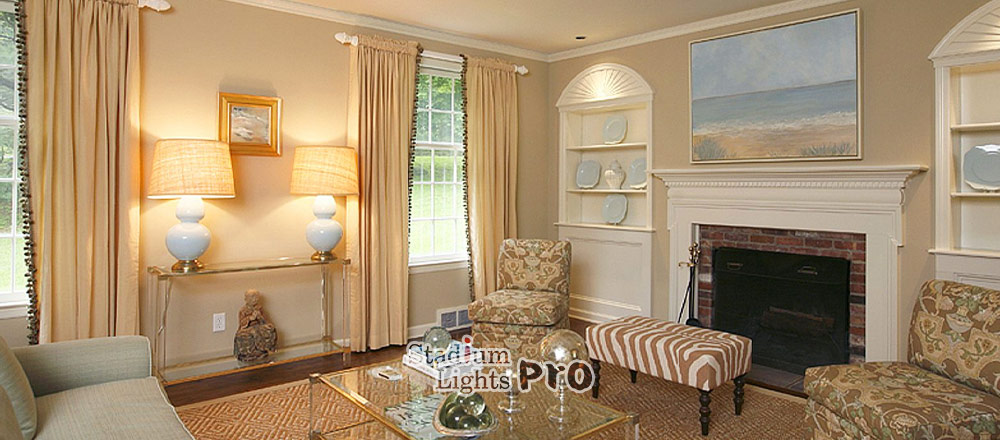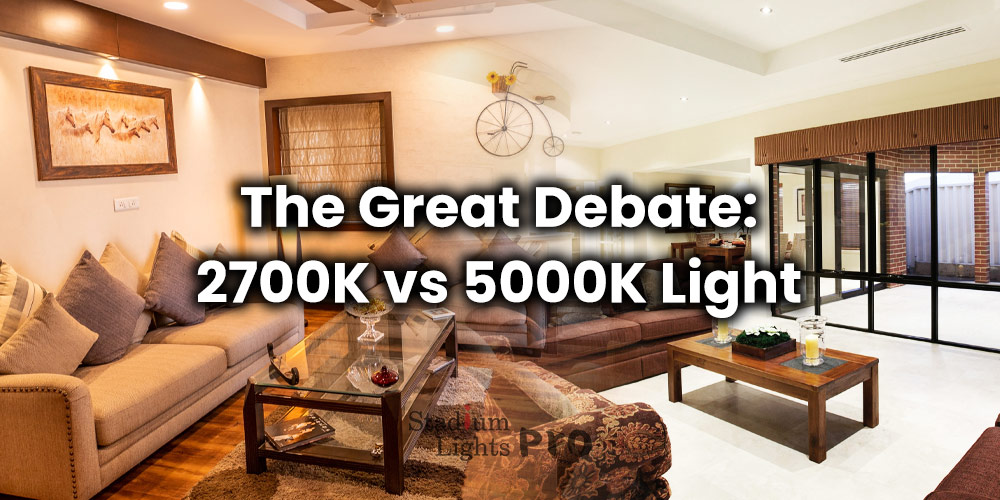Light color temperature is measured in Kelvins (K) and it indicates the color of the light produced by a particular light source. The higher the color temperature, the cooler and more bluish the light appears; the lower the color temperature, the warmer and more yellow the light appears.
This article would be suitable for anyone who is interested in understanding the differences between 2700K and 5000K light, and how to choose the right light temperature for their specific needs. This may include:
- Homeowners who want to improve the lighting in their home
- Business owners seeking to enhance the lighting in their office or commercial property
- Interior designers and architects looking to specify lighting for a project
- DIY enthusiasts looking to learn more about lighting options
- Electricians and lighting professionals looking to expand their knowledge of light temperature options.
Table of Contents
ToggleWhat is 2700K and 5000K lighting?

2700K light is considered “warm white” and has a yellowish-orange hue, similar to the color of a traditional incandescent bulb. It is often used in residential settings to create a cozy and inviting atmosphere.
On contrast, 5000K light is referred as “daylight” and it gives off a cool and bluish-white hue. It is popularly used in commercial and industrial environments as it mimics the natural sunlight and enhance visibility and productivity. While, 2700K light is considered more soothing and suitable for creating an ambient atmosphere, 5000K light is invigorating and ideal for task lighting.
What are the applications of 2700K vs 5000K lighting?

2700K light is often used in residential settings as it creates a warm, cozy, and inviting atmosphere that is perfect for ambient lighting.
5000K light is used in commercial and industrial settings as it mimics natural daylight and helps to increase productivity and visibility. Some common applications of 2700K and 5000K light include:
| Applications of 2700K lights | Applications of 5000K lights |
| Living rooms and family rooms – The warm and inviting color temperature of 2700K light is ideal for creating a comfortable and relaxing space for socializing and spending time with family. | Offices and workspaces – The cool and bright color temperature of 5000K light can help to increase productivity and focus, making it ideal for workspaces. |
| Bedrooms – to create a relaxing and calming atmosphere that is perfect for sleeping. | Retail spaces – create a clean and inviting atmosphere in retail spaces. |
| Kitchens and dining rooms – 2700K lighting creates a warm and inviting atmosphere for cooking and dining, similar to the light produced by traditional incandescent bulbs. | Industrial settings – 5000K light is ideal for industrial settings as it helps to increase visibility and safety. |
| Bathrooms – create a relaxing atmosphere, similar to the light produced by traditional incandescent bulbs. | Hospitals and medical facilities – often used in hospitals and medical facilities to create a clean and sterile atmosphere, and to help with visibility for medical staff. |
Choice of material vs color temperature
The choice of color temperature (2700K or 5000K) for lighting in a home can depend on the type of wall and floor materials, as well as the overall aesthetic and desired ambiance of the space.
2700K lighting can be particularly well-suited for spaces with darker or more muted wall and floor colors, such as deep reds, blues, or browns. The warm tones of 2700K lighting can also help to enhance the natural colors and textures of wood, stone, and other natural materials.
5000K lighting is well-suited for spaces with lighter or more neutral wall and floor colors, such as whites, grays, or beiges. The cool tones of 5000K lighting can also help to enhance the clean lines and modern aesthetic of contemporary materials such as tile, metal, and glass.
The choice of color temperature should reflect your personal preference and the ambiance you want to create in the room.
Pros and cons of 2700K vs 5000K lights

The table below provides a comprehensive overview of the advantages and disadvantages of 2700K & 5000K lighting and by reading it, one can have a better understanding of when to use them in different settings and applications. It’s a useful tool for architects, interior designers, and anyone else who wants to create the perfect lighting environment for a specific space or purpose.
| 2700K | 5000K |
| Warm and cozy atmosphere – The 2700K color temperature is considered “warm white” and creates a comfortable and inviting ambiance, making it a great option for living rooms, bedrooms, and other spaces where people spend a lot of time relaxing. | Bright and natural-looking light – The 5000K color temperature is considered “daylight” and creates a bright and natural-looking light that is similar to the light of a clear day. |
| Good for relaxing and reading – The warm and cozy atmosphere created by 2700K lights makes it a great option for reading, relaxing, and other activities that don’t require high visual acuity. | Good for tasks and activities that require high visual acuity – The bright and natural-looking light of 5000K lights makes it a great option for tasks and activities that require high visual acuity, such as studying, working, and performing detailed tasks. |
| Lower color rendering index (CRI) – With a lower CRI, colors may appear less accurate and vibrant under 2700K lights. | Higher color rendering index – With a higher CRI, colors appear more accurate and vibrant under 5000K lights. |
| Can make skin tones appear yellowish or orange – Due to the way that it interacts with the pigments in the skin. The warm light causes the red and yellow pigments in the skin to appear more prominent, which can give skin a yellow or orange cast. | Can make skin tones appear more natural – The bright and natural-looking light of 5000K lights can make skin tones appear more natural, which can be beneficial in settings such as makeup application and hair salons. |
Comparison of 2700K and 5000K lights
Visual comparison
A visual comparison of 2700K and 5000K light can be seen by looking at the color of the light itself. 2700K light has a warm, yellowish color that creates a cozy and inviting atmosphere. On the contrary, 5000K light has a cool, blue-ish white color that creates a bright, natural-looking light similar to daylight.
When comparing the two lights in a room setting, 2700K light may make the room feel warm and cozy, while 5000K light may make the room feel more bright and open. The colors of objects in the room will also appear differently under each type of light. Under 2700K light, colors may appear less accurate and vibrant, while under 5000K light, colors will appear more true to life and accurate.
The human eye can adapt to different lighting conditions, and it’s also affected by other factors like the amount of light in a room, the surrounding colors, and the visual tasks being performed. So, we need to take into account other factors when deciding which light temperature is better for a specific space or application.
Comparison of energy efficiency (2700K and 5000K LED)
Comparing the energy efficiency of 2700K and 5000K lights can be a bit more complex than comparing their visual characteristics. Both types of lights can come in a variety of technologies, such as incandescent, fluorescent, and LED, each with different energy efficiency ratings.
LED lights are considered to be the most energy-efficient option, regardless of the color temperature. When comparing 2700K and 5000K LED lights, the difference in energy efficiency may be negligible.
Fluorescent lights also offer a high level of energy efficiency, but are generally less efficient than LED lights. Incandescent lights are less energy-efficient than both LED and fluorescent lights, and are not recommended for energy-efficient lighting.
The energy consumption of a light can be affected by the amount of time it’s used, how well it’s been maintained and the quality of the product.
2700K vs 5000K LED lighting frequently asked questions
Is 2700K too warm?
The color temperature of 2700K is considered “warm white” and is generally considered to be on the warm side of the spectrum. Whether or not 2700K is considered “too warm” can depend on personal preference and the specific application or setting in which the lighting is being used.
Some people may find 2700K to be too warm for certain tasks or activities that require high visual acuity, such as reading or working, as the warm light can make it more difficult to see fine details and text. In this case, a cooler color temperature such as 5000K might be more suitable.
Yet, in spaces where people spend a lot of time relaxing and unwinding, such as living rooms and bedrooms, the warm and cozy atmosphere created by 2700K lights can be very pleasing and relaxing.
2700K is not very warm in comparison with other options available in the market, like 2200K or 2000K, which are considered extremely warm and can produce yellow light that can be hard to look at for a long time.
Is 2700K or 5000K bright enough?
2700K light is generally considered to be less bright than 5000K light, due to the warm and cozy atmosphere created by the yellowish color of the light. This type of light is ideal for spaces where people spend a lot of time relaxing and unwinding, such as living rooms and bedrooms, where a lower level of light is desired.
5000K light is generally considered to be brighter than 2700K light, due to the cool, blue-ish white color of the light. This type of light is ideal for tasks and activities that require high visual acuity, such as studying, working and performing detailed tasks, where a higher level of light is needed.
Is 5000K same as daylight?
5000K is considered to be similar to the color temperature of daylight, but it is not exactly the same. Daylight, or natural light, can vary depending on the time of day, weather conditions, and location. The color temperature of daylight can range from around 2000K at sunrise and sunset to around 6000K at noon on a clear day.
Even though 5000K is considered to be similar to daylight, it can still be different from natural light, especially when it comes to the intensity and the distribution of light, which can affect the perception of color and the visual comfort of the space.
Is 2700K or 5000K too bright for kitchen?
Whether 2700K or 5000K is too bright for a kitchen depends on personal preference, the specific design of the kitchen and the amount of natural light that the kitchen receives.
In a kitchen, this type of light can be useful for tasks such as food preparation and cooking, where accurate color rendering and high visual acuity are essential. However, if the kitchen already receives a lot of natural light, 5000K lights might be too bright and create a harsh ambiance.
While 2700K light is great for relaxing and unwinding, it’s not ideal for tasks that require high visual acuity, such as food preparation and cooking. If the kitchen does not receive a lot of natural light, 2700K lights might not be bright enough for the tasks that need to be performed in the kitchen.
It’s recommended to consider the use of dimmable lights, which can be adjusted to suit different tasks and moods, and task lighting, which can be directed to specific areas where more light is needed.
How do 2700K and 5000K affect mood and productivity?
2700K light is known for its warm and relaxing properties, making it ideal for creating a cozy and comfortable atmosphere in a room. It is often recommended for bedrooms and living rooms as it can help promote relaxation and sleep.
5000K light is known for its bright and energizing properties, making it ideal for tasks that require high levels of concentration and focus. It is often recommended for kitchens, bathrooms, and offices as it can help improve productivity and alertness.
Does 2700K or 5000K lighting suppress the release of melatonin?
The color temperature of lighting, measured in Kelvins (K), is one factor that can affect the release of melatonin, a hormone that regulates sleep-wake cycles. Melatonin release is triggered by darkness and suppressed by light, and the wavelength of light plays a role in this process.
2700K lighting is less likely to suppress melatonin release compared to 5000K lighting. However, the impact of lighting on melatonin release can vary depending on the individual and their sensitivity to light. It’s best to consult with a professional for a personalized recommendation.
Are there any health benefits associated with 2700K and 5000K light?
Both 2700K and 5000K light can have an impact on our health and well-being. 2700K light is known to help regulate our circadian rhythm and promote better sleep. It has also been found to have a calming effect on our mood and reduce symptoms of anxiety and depression.
5000K light has been found to improve cognitive function, boost energy levels, and improve overall mood. It is also known to be effective in treating Seasonal Affective Disorder (SAD) and other forms of depression.
Are there any downsides to using 2700K or 5000K light?
While both 2700K and 5000K light have their own set of benefits, there are also downsides to using them. 2700K light can make it difficult to see certain colors, especially in areas such as kitchens and bathrooms where tasks require high levels of visibility. This can cause eye strain and make it difficult to complete tasks that require precision.
5000K light can create a cool and sterile atmosphere, which can be uncomfortable for some people. It can also cause headaches and eye strain if used for long periods of time.
Are 2700K and 5000K interchangeable?
While both 2700K and 5000K light can be used in a variety of settings, they are not interchangeable and have different effects on our mood and productivity. 2700K light is better suited for creating a relaxing and cozy atmosphere, while 5000K light is better suited for tasks that require high levels of concentration and focus.
Conclusion
The choice between 2700K and 5000K lighting depends on the specific application or setting in which the lighting is being used and personal preference.
If you’re considering which type of lighting to use in your home or office, whether it’s 2700K or 5000K, our team of experts is here to help. We offer a free lighting consultation service to help you make an informed decision about which type of lighting is best for your specific needs. During the consultation, we will take into account factors such as the specific application or setting in which the lighting will be used, personal preference, and the amount of natural light in the space. We will also provide information about the energy efficiency of different lighting options and help you to decide which type of lighting will be most suitable for your space.
Our team of lighting experts have years of experience in the field and have helped many clients to create the perfect lighting environment for their homes and businesses. We understand that choosing the right lighting can be a daunting task, but with our help, you can be sure that you’re making the right decision. We’ll work with you to create a lighting plan that will not only look great but also suit your needs, whether it’s for reading, relaxing or performing detailed tasks.
Don’t hesitate to reach out to us for a free lighting consultation. We’re here to help and are happy to answer any questions you may have about 2700K vs 5000K lighting.

